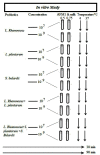Aflatoxin M1-Binding Ability of Selected Lactic Acid Bacteria Strains and Saccharomyces boulardii in the Experimentally Contaminated Milk Treated with Some Biophysical Factors
- PMID: 32292004
- PMCID: PMC8410163
- DOI: 10.22092/ari.2019.123985.1265
Aflatoxin M1-Binding Ability of Selected Lactic Acid Bacteria Strains and Saccharomyces boulardii in the Experimentally Contaminated Milk Treated with Some Biophysical Factors
Abstract
There is a growing concern regarding the recurrent observation of aflatoxins (AFs) in the milk of lactating animals. Regarding this, the present study was conducted to assess the aflatoxin M1 (AFM1)-binding ability of three species, namely Lactobacillus rhamnosus, L. plantarum, and Saccharomyces boulardii, inAFM1-contaminatedmilk. The mentioned species were administeredatthe concentrations of107 and 109 CFU/mLto skimmed milk contaminated with 0.5 and 0.75 ng/mL AFM1 within the incubation times of 30 and 90 min at 4°C and 37°C. Lactobacillus rhamnosus was found to have the best binding ability at the concentrations of 107 and 109 (CFU/ml), rendering 82% and 90% removal in the milk samples with 0.5 and 0.75 ng/ml AFM1, respectively. Accordingly, this value at 107 and 109 CFU/ml of L. plantarum was obtained 89% and 82% with 0.75 ng/ml of AFM1, respectively. For S. boulardii at 107 and 109 CFU/ml, the rates were respectively estimated at 75% and 90% with 0.75 ng/ml of AFM1. The best AFM1-binding levels for L. rhamnosus, L. plantarum, and S. boulardii were 91.82±10.9%, 89.33±0.58%, and 93.20±10.9, respectively, at the concentrations of 1×109, 1×107, and 1×107 CFU/ml at 37, 4, and 37°C, respectively. In this study, the maximum AFM1 binding (100.0±0.58) occurred while a combination of the aforementioned probiotics was employed at a concentration of 1×107 CFU/ml at 37°C with 0.5 ng/ml AFM1, followed by the combination of L. rhamnosus and L. plantarum (95.86±10.9) at a concentration of 1×109 CFU/ml at the same temperature with 0.75 ng/ml AFM1. It was concluded that the use of S. boulardii in combination with Lactobacillus rhamnosus and L. plantarum, which bind AFM1 in milk, can decrease the risk of AFM1 in dairy products.
Keywords: AFM1; Lactobacillus plantarum; Lactobacillus rhamnosus; Milk; Saccharomyces boulardii; decontamination.
Copyright © 2020, Archives of Razi Institute. Published by Kowsar.
Conflict of interest statement
The authors declare that they have no conflict of interest.
Figures
Similar articles
-
Detoxification of aflatoxin M1 by probiotics Saccharomyces boulardii, Lactobacillus casei, and Lactobacillus acidophilus in reconstituted milk.Gastroenterol Hepatol Bed Bench. 2022 Summer;15(3):263-270. doi: 10.22037/ghfbb.v15i3.2402. Gastroenterol Hepatol Bed Bench. 2022. PMID: 36311958 Free PMC article.
-
Removing aflatoxin M1 from milk with native lactic acid bacteria, centrifugation, and filtration.Arh Hig Rada Toksikol. 2018 Dec 1;69(4):334-339. doi: 10.2478/aiht-2018-69-3160. Arh Hig Rada Toksikol. 2018. PMID: 30864375
-
Identification of Dairy Fungal Contamination and Reduction of Aflatoxin M1 Amount by Three Acid and Bile Resistant Probiotic Bacteria.Arch Razi Inst. 2021 Mar;76(1):119-126. doi: 10.22092/ari.2019.126572.1347. Epub 2021 Mar 1. Arch Razi Inst. 2021. PMID: 33818964 Free PMC article.
-
Assorted Methods for Decontamination of Aflatoxin M1 in Milk Using Microbial Adsorbents.Toxins (Basel). 2019 May 29;11(6):304. doi: 10.3390/toxins11060304. Toxins (Basel). 2019. PMID: 31146398 Free PMC article. Review.
-
Control of aflatoxin M1 in milk by novel methods: A review.Food Chem. 2020 May 1;311:125984. doi: 10.1016/j.foodchem.2019.125984. Epub 2019 Dec 9. Food Chem. 2020. PMID: 31855773 Review.
Cited by
-
Isolation, Identification, and Characterization of the Native Yeast Strains from Homemade Cheese to Assess their Eliminating Impact on the Aflatoxin B1 and M1 of the Simulated Gastrointestinal Fluid.Iran J Biotechnol. 2023 Apr 1;21(2):e3291. doi: 10.30498/ijb.2023.330834.3291. eCollection 2023 Apr. Iran J Biotechnol. 2023. PMID: 37228633 Free PMC article.
-
Detoxification of aflatoxin M1 by probiotics Saccharomyces boulardii, Lactobacillus casei, and Lactobacillus acidophilus in reconstituted milk.Gastroenterol Hepatol Bed Bench. 2022 Summer;15(3):263-270. doi: 10.22037/ghfbb.v15i3.2402. Gastroenterol Hepatol Bed Bench. 2022. PMID: 36311958 Free PMC article.
-
Effectiveness of various methods to reduce aflatoxin M1 levels in milk, a systematic review.Food Chem X. 2024 Aug 13;23:101737. doi: 10.1016/j.fochx.2024.101737. eCollection 2024 Oct 30. Food Chem X. 2024. PMID: 39263340 Free PMC article. Review.
-
Box-Behnken Design for Assessing the Efficiency of Aflatoxin M1 Detoxification in Milk Using Lactobacillus rhamnosus and Saccharomyces cerevisiae.Life (Basel). 2023 Jul 31;13(8):1667. doi: 10.3390/life13081667. Life (Basel). 2023. PMID: 37629525 Free PMC article.
References
-
- Abbès S, Salah-Abbès JB, Sharafi H, Jebali R, Noghabi KA, Oueslati R. Ability of Lactobacillus rhamnosus GAF01 to remove AFM1 in vitro and to counteract AFM1 immunotoxicity in vivo. J Immunotoxicol. 2013;10(3):279–86. - PubMed
-
- Bahrami R, Shahbazi Y, Nikousefat Z. Aflatoxin M1 in milk and traditional dairy products from west part of Iran: occurrence and seasonal variation with an emphasis on risk assessment of human exposure. Food Control. 2016;62:250–6.
-
- Baranyi N, Kocsubé S, Varga J. Aflatoxins: Climate change and biodegradation. Curr Opin Food Sci. 2015;5:60–6.
-
- Bhatnagar-Mathur P, Sunkara S, Bhatnagar-Panwar M, Waliyar F, Sharma KK. Biotechnological advances for combating Aspergillus flavus and aflatoxin contamination in crops. Plant Sci. 2015;234:119–32. - PubMed
MeSH terms
Substances
LinkOut - more resources
Full Text Sources
Medical

